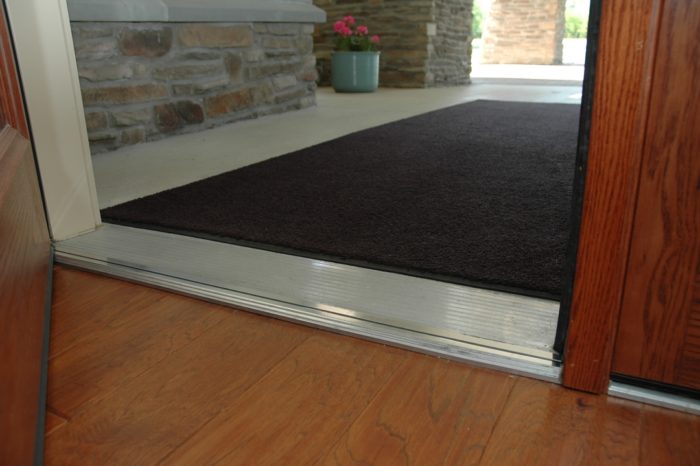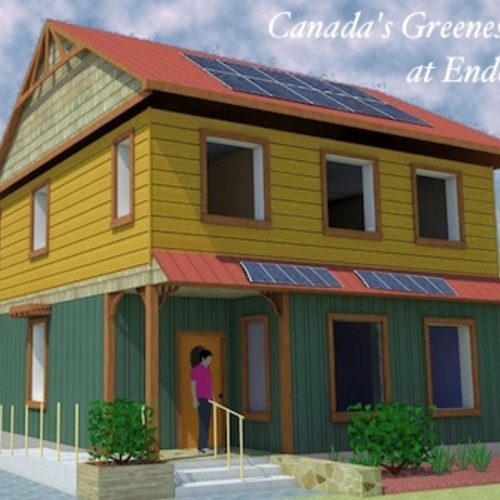
Image Credit: Photo #1 through #9: Mark Leder
Image Credit: Photo #1 through #9: Mark Leder A worker uses rubber-backed tape to join sections of rubber flooring underlayment. This floating floor assembly (with flooring that is glued together at the edges) creates a perceptible "softness" underfoot. This casement window crank compactly folds when not in use. The single-lever toggle on the right operates the latch. The latch mechanism includes an internal vertical sliding bar that securely pins the sash to the frame at the top and bottom. Carpenters installed 3/4-inch plywood blocking to prepare for the installation of grab bars near the toilet. The center of the toilet flange is positioned 18 inches from the finished side wall and 12 inches from the finished rear wall. The grab bar brackets were fastened to the plywood blocking behind the drywall with screws. The toilet area with the grab bar installed. Note the decorative screen on the left, which can be slid into a wall pocket, allowing more room for a power wheelchair or an assistant to access the toilet. The recycled composite quartz material installed on the walls of the shower facilitates easy maintenance. The slip-resistant floor has a continuous length channel drain which quickly drains water from the area, reducing the duration of elevated humidity. This fiberglass entry door has a decorative glass pane sandwiched between two outer glass layers. The "leading" applied over the translucent pane includes circular peepholes at different elevations. Each peephole was filled with a leveling liquid that hardens to provide clarity for viewing. Workers install permeable pavers on a prepared bed of compacted sharp gravel and limestone fines. The pavers' edges are convoluted, so that small wheeled assistive devices are less likely to get "caught." An exterior view of the completed house.
Image Credit: Photo #10: Scott Cunningham
On June 13, 1998, my husband, Mark Leder, and I went for a bicycle ride on a rural wooded trail in Granville, Ohio. After riding for a few minutes, Mark thought he heard a gunshot and slowed down to investigate. As he scanned the scene he saw a large tree falling. He shouted, “Stop!” But the warning was too late. I was crushed by a 7,000-pound tree and paralyzed from the waist down.
Coming home from the hospital in a manual wheelchair after my spinal cord injury, I realized how my two-story home intensified my disability. My husband and I knew that we had to sell our home and find something more suitable.
In September 2004, we hired an architect to draw the house plans for our new home in Columbus, Ohio. There was a steep learning curve for me in ramping up to build our home. We assembled a team of interior designers and over 200 corporate contributors to assist us. Serving as the general contractors, my husband and I spent 32 months building our home.
This home, named the “Universal Design Living Laboratory,” is the top-rated universal design home in North America; earning three national universal design certifications. (Here is the link to take a virtual tour of our home.)
The concept of universal design has been embraced by architects, interior designers, and other design and building professionals since the 1980s. It is a framework for the design of living and working spaces and products benefiting the widest possible range of people in the widest range of situations without special or separate design. Universal design is human-centered design, accommodating people of all sizes, ages, and abilities. Universal design creates social justice, providing opportunities for more personal activity and mobility.
Having lived in the Universal Design Living Laboratory using a wheelchair for the past five years, I have a unique perspective. I have learned the importance of space planning and that small differences in the width of a door, height of a threshold, or slope of a ramp can impact a person’s independence. I have experienced the joy of rolling on hardwood and tile flooring. No longer do I have sore shoulders as I did when rolling on the carpet in my previous home. Safety features like grab bars in the toileting area and shower have kept me from falling, and they make transfers easier. Life is easier when a home includes universal design features and products.
Incorporating green features and products
When my husband and I began the planning process to design our home we wanted to include green features and products in addition to universal design. We were aware that a green home is healthier, conserves natural resources, protects the environment, is more energy-efficient and sustainable. The concept of being sustainable has three components: environmental, economic, and social.
In 2009, when my husband and I were reviewing the LEED certification application with the U.S. Green Building Council for our home, we discovered that no points would be earned for the universal design features in our home. I had a discussion with representatives of the USGBC and asked, “How can a home be sustainable if it isn’t accessible?”
The USGBC was receptive to my suggestion that points be added to the LEED certification program for universal design features. They hired a consultant who interviewed me and others to create a list of universal design and visitable features that would be added to the next version of the LEED application. Visitable features in a home enable people who use wheelchairs and walkers access into the home through a no-step entrance, a 36-inch-wide entry door, and access to a half bathroom on the first floor.
A home that is socially sustainable will serve the family that lives in the home for many years. People will be able to enter the home easily, even if they use wheelchairs and walkers. Universal design features and products improve the occupant’s ability to be independent. When universal design features are incorporated into the home design from the beginning, there is less likelihood that the home will need to be remodeled should the occupants acquire a disability or sustain an injury.
As a result of our planning and construction practices, our home earned a Silver LEED rating from the U.S. Green Building Council. It received a Gold rating on the National Green Building Standard certification program through the National Association of Home Builders.
Selecting products that support green and universal design
When we began selecting the construction materials, products, and appliances, we evaluated each of them on the criteria that they be both green and universal design. We read labels looking for the structural components that may offgas volatile organic compounds. We looked for verification that they were energy-efficient, made of sustainable products or recycled materials, and used less water.
Here are a few of the products that we selected that are both green and universal design.
Engineered hardwood flooring
When the time came to select flooring, we knew that the flooring had to be easy to roll on in a wheelchair or walker. We selected a hickory veneer engineered hardwood flooring with a matt finish to prevent glare. We installed this flooring on a 4 mm. thin acoustic underlay engineered from recycled rubber tires (see Image #2, below). This mat reduces the sound transmission through subfloors and is softer on people’s joints when walking.
In a universal design home, there are green options for hardwood flooring. Bamboo is a fast-growing grass and is harder than maple or oak. Eucalyptus is a hard and durable wood that is harder than cherry or walnut.
If carpeting is preferred in a home, select one that is easy to roll on in a wheelchair. Choose a carpet with a thin pad underneath and a low pile. One green recycled fiber carpet choice is made of polyester fiber recovered from plastic soda bottles. Wool carpets are also considered green.
Casement windows
A way to save on heating and cooling bills is to install multiple pane low-e windows filled with argon gas. Some types of low-e coatings significantly block the sun’s ultraviolet rays.
Casement windows are preferred to double-hung windows due to their ease of operating, especially for a person who uses a wheelchair (see Image #3, below). These windows allow more air circulation due to the size of the operating sash. The window locks must be reachable from a seated position.
A toilet with a 17-inch-high seat
When choosing a toilet, select one that will use less water. WaterSense labeled toilets use 1.28 gallons per flush or less while still providing equal or superior performance.
Select a toilet that is a little taller than the standard toilet which is 15 inches from the floor to the top of the seat. A 17-inch-high toilet seat makes it easier to get on and off, to transfer to and from a wheelchair.
Also, install a grab bar on the wall next to the toilet to make transfers safer and easier. The grab bar should be positioned at a height that is convenient for the occupant, generally between 33 inches and 36 inches from the floor. Be sure to reinforce the wall with plywood or wood blocking to secure the grab bar (see Images #4, #5, and #6, below).
Adjustable showerheads and hand showers
Adjustable height hand showers mounted on a vertical bar provide more benefits than a showerhead mounted on a shower wall (see Image #7, below). Hand showers should have at least a 6-foot-long hose. People who need to be seated in order to take a shower have the independence and greater adjustability to position the showerhead on the vertical bar. This bar on many models is constructed so that it also serves as a grab bar. Additional horizontal grab bars will be needed in the shower for safety.
Showerheads on hand showers should be lightweight and ergonomic. Ranges in cost may be due to a number of factors including material composition, integrated technology, size, style, functional design, finish, and the life of the warranty.
To conserve the amount of water used to take a shower, select a showerhead that is WaterSense labeled. The specification is that the maximum flow rate value of the showerhead must be equal to or less than 2.0 gallons of water per minute. Water is conserved by mixing more air into the water stream. By installing high-efficiency hand showers, the average household could save more than 2,300 gallons of water per year. Since these water savings will reduce demands on water heaters, households will also save on energy costs.
Wide doors with lever handles
To make each room more accessible for people who use wheelchairs or scooters, install 36-inch-wide doors. Also, install lever handles rather that door knobs (see Image #8, below). Lever handles are easier to operate for people with paralysis or arthritis. The cost difference for these wider doors and lever handles is minimal. The benefits are long-lasting, providing for independence and greater access to the entire home.
Exterior door thresholds should be ½ inch or lower to be easier to roll over in a wheelchair. The exterior main door should have multiple height peepholes or include glass in the design so that all residents can view the porch to see who is there.
Heavily insulated fiberglass exterior doors are a weather-resistant energy-efficient green solution. Select interior doors made from fast-growing wood species like poplar or from lumber certified by a credible third-party certification program like the Sustainable Forestry Initiative.
Permeable landscape pavers
When selecting landscape pavers, consider those that are compliant with the Americans with Disabilities Act. They meet pedestrian slip-resistance standards with a static coefficient of friction of 0.8 and offer smooth travel for people using wheelchairs.
Permeable pavers allow for rain and melted snow to percolate through the pavers, making these a green choice (see Image #9, below). In an environment with freezing temperatures, these permeable pavers are a great choice since water doesn’t accumulate and they are less likely to ice over and are therefore safer to walk on.
Consider long-term value when weighing the initial product cost
When comparing prices on products that have green and universal design features compared to those that do not, recognize the benefits to the occupants and the saving in the long run. Universal design features provide more independence, safety, accessibility, and comfort. Green features provide energy and water savings.
In view of the benefits over the long haul, the investment in these products becomes an easy choice.
Rosemarie Rossetti, Ph.D. works with architects, designers, builders, and consumers that want to create inspired and livable homes (web site: UDDL.com). She is an internationally known speaker, consultant, and author (RosemarieSpeaks.com). Her newest resource, the Universal Design Toolkit, is an illustrated 200-page e-book with online videos and webinars.
Weekly Newsletter
Get building science and energy efficiency advice, plus special offers, in your inbox.















6 Comments
Grab bar support
Many grab bars have weight limit to 300-350 lbs. and 3/4 plwd may not be strong enough to support them in toilets and showers. As a good alternative I recommend to use "waste" 2x6, 2x8, etc. lumber that otherwise is going to the dump, and in the process, you save in disposal fees too. Make sure those details are on the plans. Feel free to use my detail in your plans.
Design
And the result is a really beautiful house.
I've only designed one house for a woman who was similarly paralyzed. One thing that came up was that her racing wheelchair was so sensitive to small slopes in the floor, that she would end up sliding away from the appliances in the kitchen of their rental apartment. We spent a lot of time coming up with strategies to keep the whole house as level as we could.
Overhangs
I believe those are some of the deepest overhangs I've seen on a house. If the author is responding, how deep are the overhangs and did they require special engineering? Also, I notice there are no gutters.
Rosemarie Rossetti's reply to overhang question
The overhangs on the Universal Design Living Laboratory roof are six feet. The roof was engineered with this in mind when it was designed. Having no gutters to clean means less maintenance. The rain and snow fall off the roof and are collected in a channel drain that surrounds the house. Some of this water is channeled to a water fall. The rest goes to drainage pipes that feed the stream behind our home. These overhangs keep the sun from heating our home in the summer.
Insulation
First of all, what a Beautiful home! I am a designer in WNY and I was wondering what type of insulation and what are the R-values that you used throughout the home? I noticed there are a large amount of windows (which I love), but quite often I will have a hard time getting a home to pass the required IRC energy calculations when there are so many windows and I believe we are in the same Climate Zone - 5A. Thank you.
Rosemarie Rossetti's reply to insulation question
Hi Christine,
Thanks for the compliment! With regards to your question, my husband, Mark Leder, who was the general contractor, wrote the following to give you the answers and details.
The first requirement is to install EnergyStar rated windows and doors. We found that that R-values and methods of sealing are of primary importance to achieving satisfactory energy calculations. So here’s a bullet point list of what we did (no particular order):
• Ceilings. We started out with R-45 cellulose (code was R-38), but increased it in the clerestory area to R-70 after we moved in (I noticed a difference when we did this). We also enhanced the air movement in the attics (this is a story in itself). The rooms around the periphery are presently R-45. We intend to do the same treatment there soon, enhancing both insulation and air movement.
• It’s important in any perimeter roof / stud wall intersection design to build in raised trusses/rafters (ours are 20 inches tall at the intersection), so that you can achieve the full R rating (and minimize ice damming) to the outside of any exterior wall.
• Exterior walls are (mostly) 2x4 SIPS, which had an R-rating of 18. You could use 2x6 SIPS and get an R-value of 21 or greater. The remaining walls (ie, south window tower of 20’ height), were 2x8 seam foamed and cellulose (damp blown). SIP panel exterior and interior seams were caulked.
• Interior walls that were common to the lower periphery attic areas, had drywall applied on the attic side, joints foamed, then damp blown cellulose to fill in between studs. Finally drywall applied to the living space side. So, with any wall assembly, it’s important to have both an air AND a thermal barrier.
• Bandboards and rim joists. On the exterior, self stick rubber roll sheeting was installed to eliminate air infiltration. The insides were foamed with closed cell material to a value of R-21.
• Any I-beams that were common to the exterior had its surface filled with closed cell foam. Areas that would be inaccessible after subsequent equipment installation and finishing (ie, bathtub), had both foam and cellulose pre-packed in to the voids.
• The full basement used Superior Walls (shipped at the time with R-5 blueboard, now R-10 by code). This gave us the opportunity to fill the 7.25” deep voids between studs with cellulose, where we achieved R-34 in most rooms. In the basement bath we had to stud in the exterior walls, that provided additional depth, so we realized R-47 in this area. Note that ONLY because there was blueboard installed did I feel confident in the effectiveness of cellulose for the basement. Otherwise I would have used another materials.
• Basement slab used R-10 blueboard taped together over gravel, followed by a specially engineered vapor barrier, prior to concrete being poured.
• Finally, I can’t emphasis enough the importance of foaming gaps. In our case, windows and doors were installed, then foamed around. I went around and foamed them all again, until excess came out of the joints. I did the same for ALL drywall wall/ceiling intersections, and around all can lights, sprinkler penetrations, electrical boxes, and ventilation (direct vent fireplace with a collar and firestop blocking), and exhaust fans, etc. Yes, there was probably more foam waste, as I had to go around and cut it off with a backsaw prior to drywall finishing, but the utility bills and the certifications speak to its effectiveness (ACH @ 50 pascals = 1.27) for about 8300 s/f of conditioned space.
Log in or create an account to post a comment.
Sign up Log in